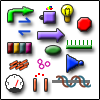Main Page/Draft
Welcome to the Registry of Standard Biological Parts.
The Registry is a collection of ~3200 genetic parts that can be mixed and matched to build synthetic biology devices and systems. Founded in 2003 at MIT, the Registry is part of the Synthetic Biology community's efforts to make biology easier to engineer. It provides a resource of available genetic parts to iGEM teams and academic labs.
The Registry is based on the principle of "get some, give some". Registry users benefit from using the parts and information available from the Registry in designing their engineered biological systems. In exchange, the expectation is that Registry users will, in turn, contribute back information and data on existing parts and new parts that they make to grow and improve this community resource.
|
Registry tools |
Related resources
|

|
You'll notice some significant changes to the Registry recently. In particular, the Registry catalog of parts has been entirely redesigned to allow for easier browsing of the available parts and devices. You can now browse parts and devices by type, by chassis and by standard. You'll also notice that the documentation and help pages for each class of parts have been greatly enhanced.
The Registry of Standard Biological Parts is *always* a work in progress. Please browse the new catalog and let us know what you think, or feel free to edit and improve the pages further. |
Registry news
- February 19, 2009: The Registry parts catalog has been revamped! Please check it out and let us know what you think.
- June 2, 2008: We are considering releasing the Registry's DNA Repository and Library system to the Registry labs and IGEM teams. This is the system we use to keep track of parts in our freezer boxes and plates. Please check it out and let us know what you think. - June 2, 2008
- June 2, 2008: A bug that kept Internet Explorer users from seeing the Part menu on Part pages has been fixed. Now, if you go to a part, you will see menu choices for hard information and physical location.
- May 26, 2008: The sequence and features for all parts are available through DAS, the Distributed Annotation System. Learn more here.
Report any bugs here | Request new features here | See new features here




